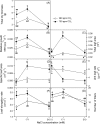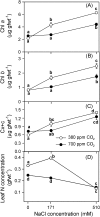Synergic effect of salinity and CO2 enrichment on growth and photosynthetic responses of the invasive cordgrass Spartina densiflora
- PMID: 20194923
- PMCID: PMC2852656
- DOI: 10.1093/jxb/erq029
Synergic effect of salinity and CO2 enrichment on growth and photosynthetic responses of the invasive cordgrass Spartina densiflora
Abstract
Spartina densiflora is a C(4) halophytic species that has proved to have a high invasive potential which derives from its clonal growth and its physiological plasticity to environmental factors, such as salinity. A greenhouse experiment was designed to investigate the synergic effect of 380 and 700 ppm CO(2) at 0, 171, and 510 mM NaCl on the growth and the photosynthetic apparatus of S. densiflora by measuring chlorophyll fluorescence parameters, gas exchange and photosynthetic pigment concentrations. PEPC activity and total ash, sodium, potassium, calcium, magnesium, and zinc concentrations were determined, as well as the C/N ratio. Elevated CO(2) stimulated growth of S. densiflora at 0 and 171 mM NaCl external salinity after 90 d of treatment. This growth enhancement was associated with a greater leaf area and improved leaf water relations rather than with variations in net photosynthetic rate (A). Despite the fact that stomatal conductance decreased in response to 700 ppm CO(2) after 30 d of treatment, A was not affected. This response of A to elevated CO(2) concentration might be explained by an enhanced PEPC carboxylation capacity. On the whole, plant nutrient concentrations declined under elevated CO(2), which can be ascribed to the dilution effect caused by an increase in biomass and the higher water content found at 700 ppm CO(2). Finally, CO(2) and salinity had a marked overall effect on the photochemical (PSII) apparatus and the synthesis of photosynthetic pigments.
Figures







Similar articles
-
Synergic effect of salinity and zinc stress on growth and photosynthetic responses of the cordgrass, Spartina densiflora.J Exp Bot. 2011 Nov;62(15):5521-30. doi: 10.1093/jxb/err234. Epub 2011 Aug 12. J Exp Bot. 2011. PMID: 21841175 Free PMC article.
-
Growth and photosynthetic responses of the cordgrass Spartina maritima to CO2 enrichment and salinity.Chemosphere. 2010 Oct;81(6):725-31. doi: 10.1016/j.chemosphere.2010.07.047. Epub 2010 Aug 16. Chemosphere. 2010. PMID: 20719357
-
Growth and photosynthetic responses to zinc stress of an invasive cordgrass, Spartina densiflora.Plant Biol (Stuttg). 2008 Nov;10(6):754-62. doi: 10.1111/j.1438-8677.2008.00098.x. Plant Biol (Stuttg). 2008. PMID: 18950433
-
Silicon alleviates deleterious effects of high salinity on the halophytic grass Spartina densiflora.Plant Physiol Biochem. 2013 Feb;63:115-21. doi: 10.1016/j.plaphy.2012.11.015. Epub 2012 Nov 28. Plant Physiol Biochem. 2013. PMID: 23257076
-
Diffusive and metabolic limitations to photosynthesis under drought and salinity in C(3) plants.Plant Biol (Stuttg). 2004 May;6(3):269-79. doi: 10.1055/s-2004-820867. Plant Biol (Stuttg). 2004. PMID: 15143435 Review.
Cited by
-
Chitosan oligomers (COS) trigger a coordinated biochemical response of lemongrass (Cymbopogon flexuosus) plants to palliate salinity-induced oxidative stress.Sci Rep. 2023 May 27;13(1):8636. doi: 10.1038/s41598-023-35931-w. Sci Rep. 2023. PMID: 37244976 Free PMC article.
-
Delineating the mechanisms of elevated CO2 mediated growth, stress tolerance and phytohormonal regulation in plants.Plant Cell Rep. 2021 Aug;40(8):1345-1365. doi: 10.1007/s00299-021-02738-w. Epub 2021 Jun 24. Plant Cell Rep. 2021. PMID: 34169360 Review.
-
From physiology to salt marsh management challenges with sea level rise: the case of native Spartina foliosa, invasive S. densiflora and their hybrid.Conserv Physiol. 2020 Jul 1;8(1):coaa053. doi: 10.1093/conphys/coaa053. eCollection 2020. Conserv Physiol. 2020. PMID: 32685163 Free PMC article.
-
Optimized gamma radiation produces physiological and morphological changes that improve seed yield in wheat.Physiol Mol Biol Plants. 2022 Aug;28(8):1571-1586. doi: 10.1007/s12298-022-01225-0. Epub 2022 Sep 17. Physiol Mol Biol Plants. 2022. PMID: 36389092 Free PMC article.
-
Impact of short-term extreme temperature events on physiological performance of Salicornia ramosissima J. Woods under optimal and sub-optimal saline conditions.Sci Rep. 2019 Jan 24;9(1):659. doi: 10.1038/s41598-018-37346-4. Sci Rep. 2019. PMID: 30679731 Free PMC article.
References
-
- Ainsworth EA, Rogers A. The response of photosynthesis and stomatal conductance to rising [CO2]: mechanisms and environmental interactions. Plant, Cell and Environment. 2007;30:258–270. - PubMed
-
- Arp WJ. Effects of source–sink relations on photosynthetic acclimation to elevated CO2. Plant, Cell and Environment. 1991;14:869–875.
-
- Asada K. Radical production and scavenging in the chloroplasts. In: Baker NR, editor. Photosynthesis and the environment. Dordrecht, Netherlands: Kluwer Academic Publishers; 1996. pp. 123–150.
-
- Bradford MM. A rapid and sensitive method for the quantitation of microgram quantities of protein utilizing the principle of protein–dye binding. Analytical Biochemistry. 1976;72:248–254. - PubMed
-
- Castillo JM, Rubio-Casal E, Redondo S, Álvarez-López AA, Luque T, Luque C, Nieva FJ, Castellanos EM, Figueroa ME. Short-term responses to salinity of an invasive cordgrass. Biological Invasions. 2005;7:29–35.
Publication types
MeSH terms
Substances
LinkOut - more resources
Full Text Sources
Research Materials
Miscellaneous

